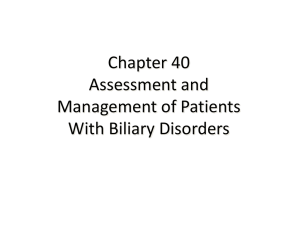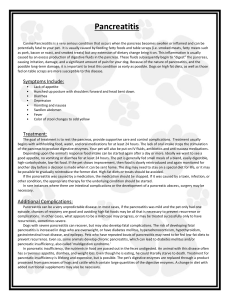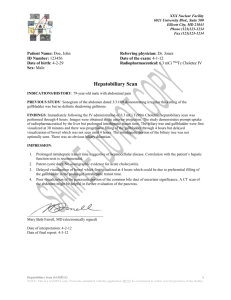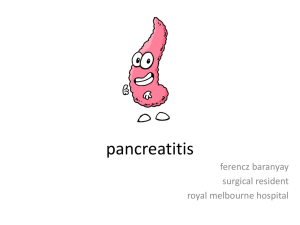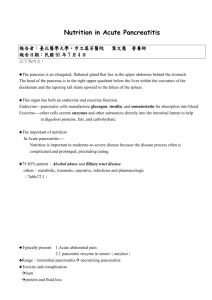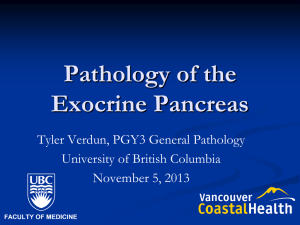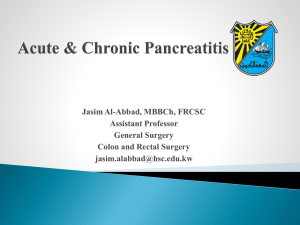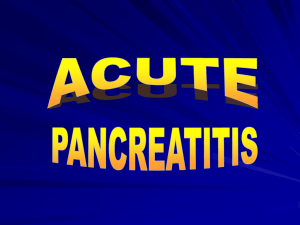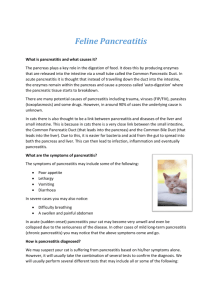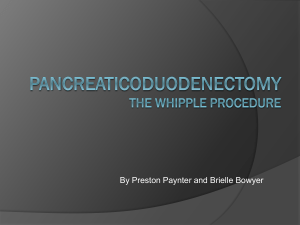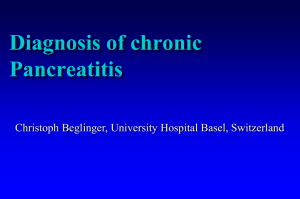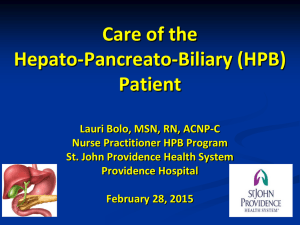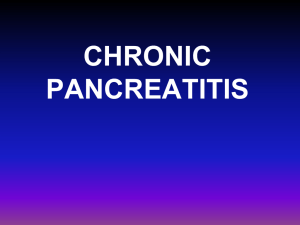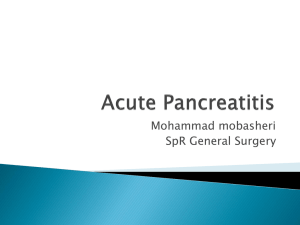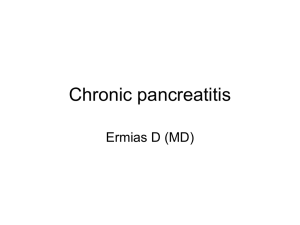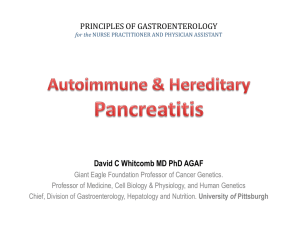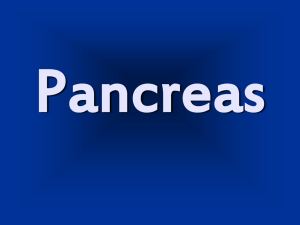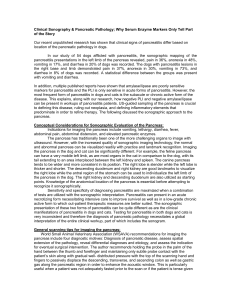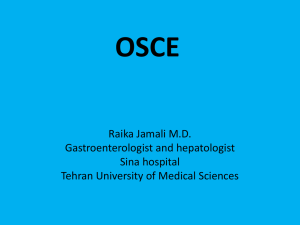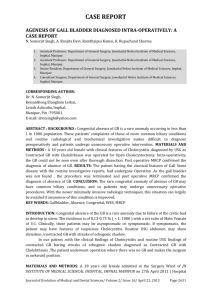Student lecture Gallbladder and Pancreas
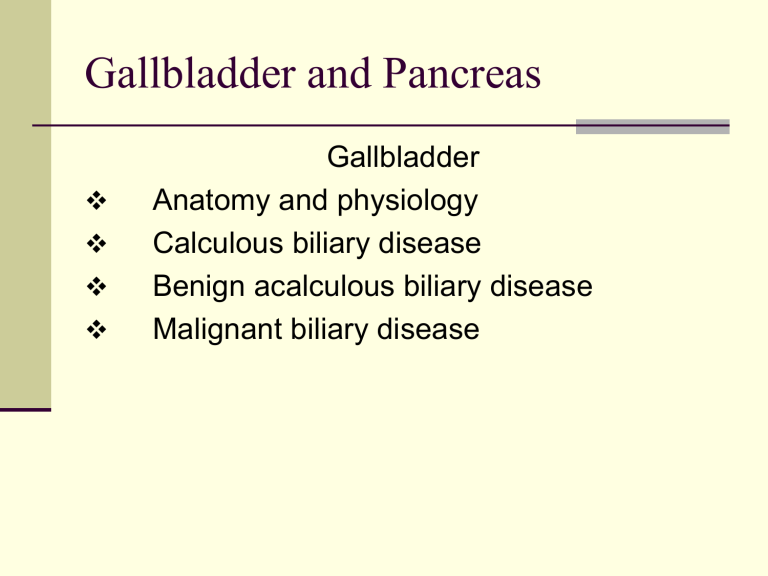
Gallbladder and Pancreas
Gallbladder
Anatomy and physiology
Calculous biliary disease
Benign acalculous biliary disease
Malignant biliary disease
Pancreas
Anatomy, embryology and histology
Physiology
Pancreatitis
Neoplasms
Calculous Biliary Disease
Incidence age and sex related
More common in females
Incidence increases with age
May remain silent
Complications include
Acute cholecystitis
Choledocholithiasis
Cholangitis
Gallstone pancreatitis
Gallstone ileus
Gallbladder adenocarcinoma
Gallstone Incidence
Gallbladder with Stones
CT of Gallbladder
Thickened wall and pericholecystic fluid
Acalculous Biliary Disease
5-10% of patients with cholecystitis
Typical patient
Critically ill
Burns
Long-term TPN
Major non-biliary operations (AAA, Cardiac bypass)
Acalculous Biliary Disease
Etiology
Unclear
Stasis and ischemia ?
Symptoms and Signs
Similar to calculous presentation
May be masked by other critical illness
Acalculous Biliary Disease
Treatment usually open cholecystectomy
Incidence of gangrene, perforation, and empyema high
Mortality 40%
Acalculous Biliary Disease
Biliary dyskinesia
More benign variant
Typical gallbladder pain without stones
HIDA scan with stimulation shows abnormal gallbladder emptying
Symptoms usually resolve with cholecystecomy
Choledocholithiasis
Choledocholithiasis
Usually due to gallstones from gallbladder
May be primary
Cholangitis (Charcot’s triad)
Fever and chills
RUQ pain
Jaundice
Choledocholithiasis
Treatment of cholangitis
IV fluids
Antibiotics
Gram negatives
Enterococcus
ERCP
Open common duct exploration
Malignant Biliary Disease
Gall bladder cancer
Bile duct cancer
CT of Gallbladder Cancer
Survival Following Resection of T2 Gallbladder Cancer
Bile Duct Carcinoma
Bile Duct Carcinoma
ERCP showing hilar tumor
Pancreas
Anatomy, embryology and histology
Physiology
Pancreatitis
Neoplasms
Pancreatic Physiology
Acute Pancreatitis
Alcohol
Gallstones
ERCP
Drugs
Pancreas divisum
Idiopathic
Causes
Ranson’s Prognostic Signs (Gallstone Pancreatitis) Admission
Initial 48 hours
Age > 70
WBC > 18K
Glucose > 220 mg/dl
LDH > 40 IU/L
AST > 250 U/dl
Hct < 10
BUN rise > 2 mg/dl
CA 2+ < 8 mg/dl
Base deficit >5 mEq/L
Fluid > 4L
Ranson’s Prognostic Signs (Alcoholic Pancreatitis) Admission
Initial 48 hours
Age > 55 yrs
WBC > 16 K
Glu > 200 mg/dl
LDH > 350 IU/L
AST > 250 U/dl
Hct fall > 10
BUN rise > 5 mg/dl
Ca 2+ < 8 mg/dl
PaO
2
< 55 mg/dl
Base deficit >4 mEq/L
Fluid > 6L
Pancreatitis
Complications
Pseudocyst
Hemorrage
Rupture
Infection
Pancreatic necrosis
Infected pancreatic necrosis
Shock and respiratory failure
Large Pancreatic Pseudocyst
Pancreatitis
Treatment
IV fluids
Pancreatic rest
NPO
NG suction if vomitting
? Antibiotics
? Octreotide
TPN
Pancreatitis
Treatment
Severe
Antibiotics
? Debridement
? Peritoneal lavage
Pseudocyst Treatment
Treat only if symptomatic
Complications rare in asymtomatic pts
Percutaneous drainage
Results variable
Infection risk ?
Surgery
Cyst-gastrostomy
Cyst-jejunostomy
Excision with pancreatectomy
Pancreas
Neoplasms
Benign Lesions
Serous cystadenoma
Mucinous cystadenoma
Intraductal papillary mucinous tumor (IPMT)
Serous Cystic Tumors
20-40% of cystic pancreatic neoplasms
Most benign with no malignant potential
Glycogen rich cells on FNA
Usually occur in body or tail
Indications for resection
? Diagnosis
Symptoms
CT scan of serous cystadenoma
Mucinous Tumors
20 – 40% of cystic tumors
Have malignant potential
Don’t communicate with pancreatic duct
Two types
Survival after resection
>50% 5 year survival without invasion
Even with invasion, survival > ductal adenoCa
Mucinous Tumors
Types of Mucinous Tumors
Less common type
Nealy always in women
Almost always in pancreatic tail
Contains areas of ovarian-like stroma
More common type
Occurs in both sexes
Lacks ovarian-like stroma
Found anywhere in pancreas
CT scan of mucinous cystadenoma
Malignant Neoplasms
Ductal Adenocarcinoma
Approx 30,500 new cases per year
Incidence increasing
4 th leading cause of cancer death
More frequent in men than women
More frequent in blacks than whites
80% occur between age 60 & 80 yrs
70% arise in head or uncinate process
Malignant Neoplasms
Ductal Adenocarcinoma
Risk factors
Age > 60 yrs
Cigarette smoking
History of hereditary pancreatitis
Occupational exposure to carcinogens
? Diabetes
? Chronic pancreatitis
Progression Model for Pancreatic Cancer
ERCP showing double duct sign
Ca Uncinate Process
Surgical Therapy – Whipple’s Operation
Trimble’s Procedure
Trimble’s Procedure
Pyloric Preservation
Pyloric Preservation
Initially recommended for pancreatitis
Less extensive resection
No difference in cancer survival
Fewer long-term GI side effects
Now standard operation for cancer
Pancreatic adenocarcinoma
Adjuvant therapy
Chemotherapy in all patients
Agents evolving
Gemcitibine becoming standard
Immunotherapy with interferon?
Radiation therapy in margin positive patients
Results of Treatment for Pancreatic
Ductal Adenocarcinoma
Unresectable patients
Mean survival 7-9 months
Palliative chemo extends survival by weeks
Resection
Survival depends on stage
Node negative, margin negative
40-45% 3 year survival
Node positive or margin positive
25-35% 3 year survival
Endocrine Neoplasms
Insulinoma
Gastrinoma
VIPoma (Verner-Morrison Syndrome)
Glucagonoma
Somatostatinoma
Nonfunctional
Insulinoma
Most common of endocrine tumors
Whipple triad
Presentation
Fatigue
Weakness
Hunger
Tremor
Diagnosis
Monitored fasting
Measurements of insulin and glucose with symptoms
Localization
Small (usually < 1.5 cm)
Usually benign
Hard to find
Arteriogram of insulinoma
CT of insulinoma
Portal venous sampling
Intraoperative US of insulinoma
Gallbladder and Pancreas
Gallbladder and Pancreas
Questions?
